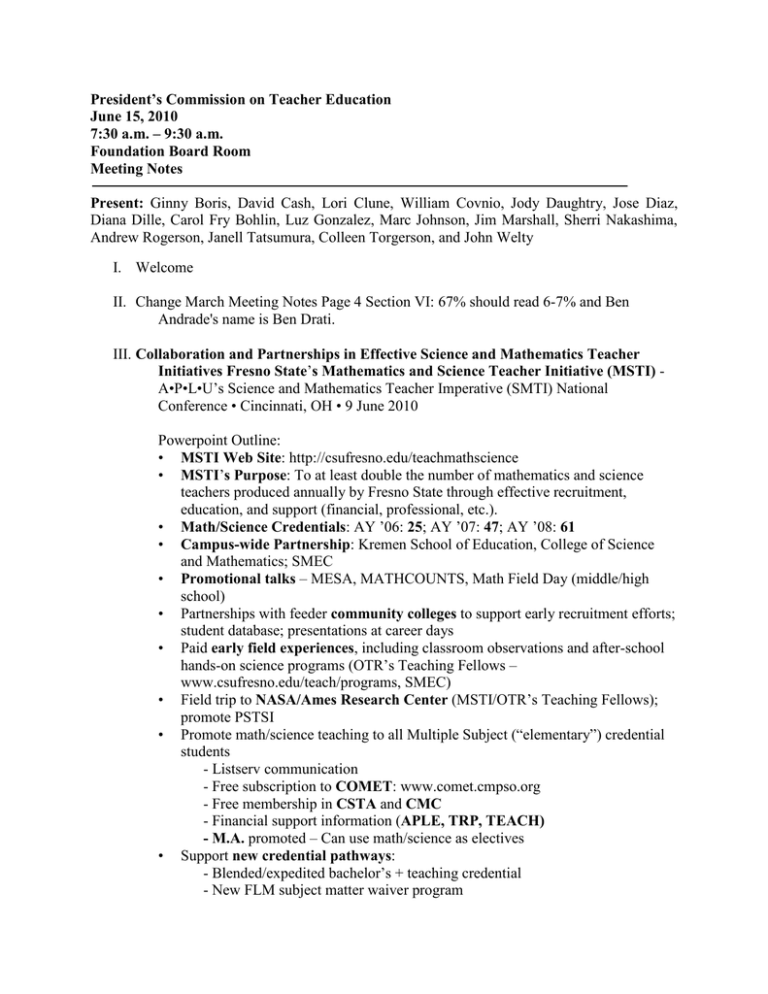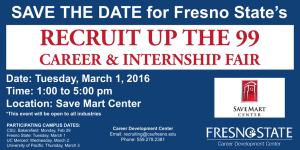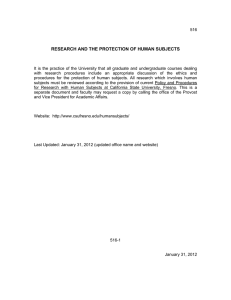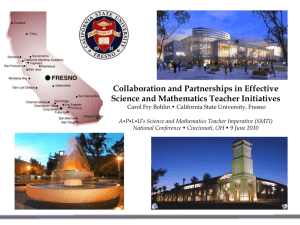President’s Commission on Teacher Education June 15, 2010 Foundation Board Room
advertisement

President’s Commission on Teacher Education June 15, 2010 7:30 a.m. – 9:30 a.m. Foundation Board Room Meeting Notes Present: Ginny Boris, David Cash, Lori Clune, William Covnio, Jody Daughtry, Jose Diaz, Diana Dille, Carol Fry Bohlin, Luz Gonzalez, Marc Johnson, Jim Marshall, Sherri Nakashima, Andrew Rogerson, Janell Tatsumura, Colleen Torgerson, and John Welty I. Welcome II. Change March Meeting Notes Page 4 Section VI: 67% should read 6-7% and Ben Andrade's name is Ben Drati. III. Collaboration and Partnerships in Effective Science and Mathematics Teacher Initiatives Fresno State’s Mathematics and Science Teacher Initiative (MSTI) A•P•L•U’s Science and Mathematics Teacher Imperative (SMTI) National Conference • Cincinnati, OH • 9 June 2010 Powerpoint Outline: • MSTI Web Site: http://csufresno.edu/teachmathscience • MSTI’s Purpose: To at least double the number of mathematics and science teachers produced annually by Fresno State through effective recruitment, education, and support (financial, professional, etc.). • Math/Science Credentials: AY ’06: 25; AY ’07: 47; AY ’08: 61 • Campus-wide Partnership: Kremen School of Education, College of Science and Mathematics; SMEC • Promotional talks – MESA, MATHCOUNTS, Math Field Day (middle/high school) • Partnerships with feeder community colleges to support early recruitment efforts; student database; presentations at career days • Paid early field experiences, including classroom observations and after-school hands-on science programs (OTR’s Teaching Fellows – www.csufresno.edu/teach/programs, SMEC) • Field trip to NASA/Ames Research Center (MSTI/OTR’s Teaching Fellows); promote PSTSI • Promote math/science teaching to all Multiple Subject (“elementary”) credential students - Listserv communication - Free subscription to COMET: www.comet.cmpso.org - Free membership in CSTA and CMC - Financial support information (APLE, TRP, TEACH) - M.A. promoted – Can use math/science as electives • Support new credential pathways: - Blended/expedited bachelor’s + teaching credential - New FLM subject matter waiver program • • • Free or inexpensive math and science courses/workshops taught by Fresno State mathematics and science faculty: - New middle school math and science teaching methods courses - Science (all areas) and math CSET (credential test) content workshops/courses (10) - ChemTeach & PhysTeach (modeling focus) Reimburse fees for CSET subtests and for credential application Invitations to partner-sponsored events: NASA workshops or SJVMP-/CVSPsponsored activities (e.g., Tech Day: GeoGebra, graphing calculator and robotics workshops; regional Lesson Study Conference; summer institutes): http://csufresno.edu/sjvmp Visit http://csufresno.edu/teachmathscience/conferences.html for MSTI conference files (sessions within the conferences’ CAMTE strands: see http://camte.org). SMEC • Full-time Assoc. Director/Counselor/Advisor (College of Science and Mathematics) Jaime Arvizu: jaimea@csufresno.edu • SMEC Executive Director: Dr. David Andrews • Grant support for preservice teachers: - Noyce I and II; Noyce Teaching Fellows: M.A./M.S. plus credential (NSF) - Hosted Western Regional Noyce Conference (April 2010) - Early Field Experience and “Science Circuit” (Walmart) - Pursuing MSP grant from NSF • Support students in attending Science Teacher and Researcher (STAR) program (through Cal Poly) and Preservice Teacher Internship Program (U.S. Dept. of Energy) • MERLOT (http://teachingcommons.cdl.edu/sec) Frank Silvestro commented that their district has had good luck with science and math teacher recruitment. IV. Social Science Single Subjects Program – Prof. Lori Clune Given three WFU’s every semester. There has been tremendous growth since 2001. At that time, 19 Social Science teachers were credentialed – it has grown to 39 per year since then. Teachers have been placed as far as Merced. Current professors are very supportive of student teachers. There is the issue of the continuation of student teaching. Lisa Bennett is one of her supervisors and they collaborated on this issue. Their results identified what is possible and communicating to help identify issues. Now student teachers meet much earlier with master teachers once they have been placed. This creates a cohort mentality. Concerns for the future: continue to look at triad method of communications. If we are all working towards the same goal we will achieve better results. She is concerned with the quality of master teachers. It is difficult for initial student teachers to be placed if there are not enough master teachers. She would like to see more “yeses” from principals when looking for schools to take student teachers. McLane took four student teachers and Sunnyside has been very responsive. Frank Silvestro asked if she ever places student teachers somewhere they did not choose.—Yes If student teachers are only placed where they want to be, are they missing opportunities at other places? Student teachers are more open-minded now than they used to be. Lori Clune is mostly concerned with the quality of master teachers. Gas is an issue for driving to outlying schools. Luz Gonzales commented that it costs a lot to send supervisors to outlying schools to check up on the student teachers. John Welty asked if we could try and use technology to connect. USC has been very successful with video conferencing with 3/4 of student teacher supervising being done via video. Luz Gonzales asked what if we offered them a $500 stipend. She was notified that $400 towards a class every year is already available to student teachers. Janell Tatsumura asked if there are any multiple-subject supervisors who live in the outlying areas? Skype was mentioned as an option for communicating. It is a responsibility to provide advising services. Carol Fry Bohlin asked if there are any courses that allow them to observe? EHD 50. James Marshall asked if it was difficult for students to have student teachers present during spring testing. David Cash said he is not sure how student teachers are place but he will find out. School that are doing well on their test scores should not have as many issues with tracking student teachers. Dianna Dille commented that teacher job fairs are really helping rural schools. V. Central Valley Higher Education Consortium – Ginny Boris Mission Statement: The aim of CVELI is to bring best leadership practices to all aspects of the education system in the San Joaquin Valley in order to eliminate the achievement gap and raise the performance of all learners. • Leadership Excellence Focus – Develop and sustain high performing educational leaders in the Central Valley. • Stakeholder and Market Focus – Instill a regional sense of urgency and awareness about the need to strengthen educational leaders to affect systemic change in the San Joaquin Valley. • • Product and Services Focus – Identify, develop, and deliver transformational services, products, and resources in collaboration with strategic partners and networks. Strategic Partnerships and Financial Focus – Develop an ongoing, sustainable resource base to fund improvement through strategic public/private partnerships Service Impact Model • Fresno Area Strive – Vision: Unite the greater metropolitan Fresno community in support of improving the success of children and ensuring more students leave high school and/or college, workforce ready. • Executive Instructional leadership Program for Rural Central Valley School Districts – Vision: Create a rural district network and collaborate to improve student achievement and address identified challenges. • Chancellor’s Center to Close the Achievement Gap – Vision: Identify, disseminate and research best practices of California’s schools that are successfully closing the achievement gap. • State Center Community College District Future Leaders Seminars – Vision: Provide leadership training for aspiring administrators in higher education. CVELI Partners • Fresno Area Strive – Fresno Compact, Central/Clovis/Fresno Unified School Districts, and Fresno County Office of Education • Executive Instructional leadership Program for Rural Central Valley School Districts – Caruthers/Corcoran/Sierra Unified School Districts, Island/Monroe/Pacific Union/Washington Colony Elementary School Districts • Chancellor’s Center to Close the Achievement Gap – CSU’s Long Beach, San Diego, and Fresno, Educational Results Partnership, and California Business for Educational Excellence. • SCCCD Future Leader’s Seminars – FCC, Reedley College, Clovis Center, Madera Center, Oakhurst Center, and Willow/International Center. • Program Partners – FCOE, Sanger Unified School District, State Center Consortium, California Association of Latino Superintendents and Administrators, and Pivot Learning Partners. • Customized Consulting Partners – Riverdale/Sanger/Sierra Unified School Districts. • Partnership Workforce Investment Act (WIA) Project – Ceres Adult School, Caruthers/Corcoran/Pacheco/Patterson High Schools, and Waterford School District. • Primary Donors – Octavia Diener, Tom and Helen Dynjan, Stan and Darlene Spano, Drs. John and Sharon Brown-Welty, Lozano Smith, EECU, Paoli and O’Dell, Inc., and Darden Architects. VI. Educational Leadership Doctoral Program – Sharon Brown-Welty There has been 19 grads from the program. The second cohort is right on track. There could be close to a 100% graduation rate. Currently looking at a new partnership with CSU, Bakersfield. There has been a drop in applications for the fourth cohort. The program is looking at twelve students for the incoming cohort. They will admit a small cohort of higher education/K-12/Special Education educators, which would help keep the numbers up. The Carnegie meeting has had an impact on the ELDP. VII. Future Meeting Suggestions • Community Colleges • Charter Schools • Keep item IV and V on agenda • Place Race to the Top on agenda Meeting adjourned at 9:45 a.m.




